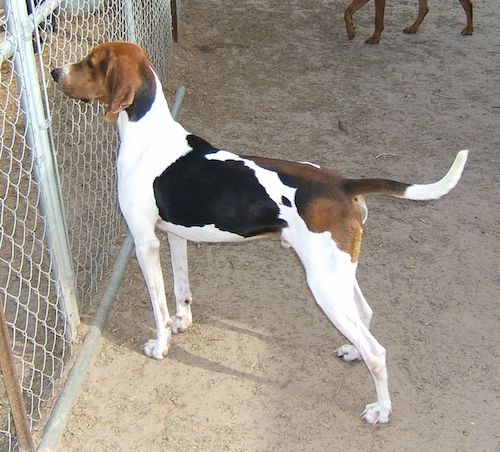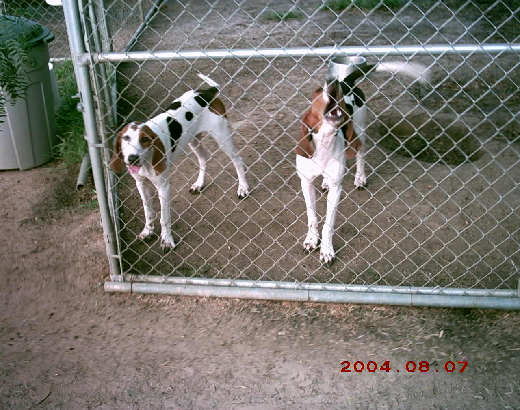
Ed note posted 8/22/20: Nearly a year ago to the day, we posted this article and concluded it with our hope of crediting the person who took the photograph we found on Pinterest). Several days ago, we heard from the photographer, “Jerry” whose last name we omit for reasons that will become apparent. In fact, we’re changing several names in the account that Jerry shared with us, but first, read the article which concludes with “the rest of the story” about the dog you see here, “Gator.”
To anyone looking in from the outside, the coonhound world is fascinating. It has its own lingo, its own tests – Nite Hunts – its own Coon Hunting Etiquette – and even its own gear (can you ever have too many good coon squaller calls?). Adding diversity to the picture are the several lines that come with its enthusiastic proponents, and we’re looking at a rich tapestry of Coonhound diversity. What they all have in common (save the Plott which is a different story) are their canine ancestors who accompanied immigrants to the United States from Europe and settled largely in the American southeast.
We won’t go into the history of the Treeing Walker Coonhound which can be read here, but rather, we want to touch upon a dog called the Running Walker Coonhound, and what differences exist between the two.
In the “looks department,” or phenotypically speaking, there isn’t much difference beyond the Running Walker being a bit smaller and lighter.
In behavior, however, it’s a different dog entirely. Though both Treeing Walkers and Running Walkers descend from the same breeding stock over a century ago, Treeing Walkers were selectively bred for their ability to run game up trees, typically raccoons, bobcats, bears, etc., while Running Walkers don’t have the treeing instinct that their cousin has (hence, the name difference. See how that works? – grin). Running Walkers, then, don’t check trees, and prefer to stay on trails that stay on the ground. They are fast, intelligent, and possess the tenacity to follow their prey for longer distances, though some hunters are of the opinion that Running Walkers have shorter attention spans than the Treeing Walkers making them a bit more challenging to train. Running Walkers are ideally suited to hunt non-arboreal animals.
And now, for “the rest of the story as told us by Jerry.
In 2004, the staff of a shelter came in to work to find three four-month-old hound puppies tied to the fence. All were bleeding from wounds on chest, front legs and neck. It was found that they were full of buckshot, and were apparently facing the shooter when shot. The director of the rescue group picked them up and took them to the facility where Jerry was a regular volunteer at the time.
The puppy bitch, “Libby,” was adopted fairly quickly by another hound rescue volunteer who was a behaviorist and thought she could help with Libby’s fears. Libby was so fearful that she had an emotional meltdown whenever she had to leave her adopter’s home, so they had to have their vet make house calls. Libby could not even be walked in their neighborhoods.
The other puppy dog, Grimm, was adopted some time later. Grimm seemed to escape the worst of the emotional issues from his early trauma.
Gator was pretty much the same basket case Libby was. When potential adopters would come to see him, he’d be at the back of his run screaming at them, particularly if they were women. This basically made him unadoptable by “normal” adopters.

“Gator” and “Grimm” at the Rescue and adoption Center. “Gator” is the one doing the talking.
At this point in time, Jerry and the other staff member were the only humans Gator trusted. Unfortunately, Jerry and his wife couldn’t take him because at the time, they had a full house of mostly Great Danes, but also a Plott Hound mix foster.
In time, Jerry heard through the rescue grapevine what might have been the story of the puppies loaded with buckshot. It seems a woman not far from a nearby town decided to become a hound breeder and acquired a pair of Running Walkers. This was her first litter, and she had no idea how to find buyers for them. As a result, by the time they were four months old she still had quite a few (no word of how many) and she decided to get rid of them. She tied all of them to a tree, and shot them. She apparently chickened out when some were dead and others were bleeding badly. She went to Plan B and took the live ones to the shelter after hours.
At this point, Jerry cautioned us that he had no way to verify any of this information, but he knew the woman’s name, and knew that a few years later, she was in court in on animal cruelty charges that were not related to the three Treeing Walkers.
When Gator was four years old, one of Jerry and his wife’s Great Danes died. Gator was still unadopted, and Jerry’s wife, knowing how close Gator and Jerry had become, arranged his adoption as a surprise. Gator started out terrified of Jerry’s wife, but she worked hard at winning him over and succeeded. In time, Gator was even able to hike with Jerry in area parks without freaking out. They had 10 wonderful years together, and he was one of their favorite dogs. Below is a photo Jerry’s wife took in the yard:

Gator, photo credit by Linda (last name withheld)
In the course of emailing back and forth, Jerry mentioned something many of you may already know, but we add it for those who don’t. As Jerry said, “There’s a lot of evil in human society, and much of it we’re not aware of unless we’re involved in a specific activity that brings us into contact with it. Rescue is one of those activities. Social work and police work are also.”
“Among other aspects of evil involving pets is its connection with human-on-human evil. Abuse of spouses, children and the elderly nearly always is preceded by (or accompanied by) abuse of animals. Traditional social or police work has usually ignored this Link. We need to make animal abuse a higher priority, even for those who aren’t interested in animal welfare, because it’s often the canary in the coalmine, indicative of likely abuse of humans.”
This is how we came to learn of “The Link,” a coalition of agencies involved in preventing family violence, and citing the need to work together for a more effective, species-spanning response. We had a chance to email-chat with Phil, Coordinator of the National LINK Coalition, and learned that Congress is considering including animal abuse histories in its national child abuse data-collection system. Animal abuse is being linked with financial abuse in domestic violence, and at a time when many state legislative sessions ended or were suspended, a whopping 93 bills were introduced in 2020 that addressed “The Link” between human and animal violence.
This is not easy reading, but it’s important to know, and to be aware of resources available to veterinarians, child protective services, community violence, and others. There is a newsletter (click here for the August 2020 edition), a handy fact sheet for veterinarians reluctant to report suspected animal abuse, and more.
Ultimately, Gator was lucky and found a wonderful home with Jerry and his wife. Others are less fortunate, and their tormentors often go on to perpetrate violence on people, and that is the link.
Our thanks to Jerry and Phil for giving us their time and information on a hugely important topic relevant to all of us.

Interesting article, but even more interesting photo. I took that photo around 2007. The hound’s name was Gator, and at the time of the photo he was at Etosha Rescue and Adoption Center in Seguin, TX. He and two siblings came there as pups from the Bastrop, TX, shelter. My wife and I adopted Gator in 2008, when he was four years old. He died in 2018. He was very camera shy, but i have a few more photos of him if you’re interested.
Hi Jerry, and thanks, yes, absolutely we’d love more photos of Gator. So that we are clear, which breed is Gator?
Hi! You omitted his name and location in the story above for obvious reason but here in the comment is his full name, location, shelter location, and where the dogs came from. I think deleting this comment (although it’s been a year and such) would help keep his animosity. Great story!
We adopted a 4 year old hound, Harry, from a rescue in the Brunswick, GA area. We were told he was a Treeing Walker Coonhound possibly mixed with a Beagle. Which we told the did to get a smaller dog for deer hunting. He knows his deer! He was found abandoned at an outdoor gun range and appears to be gun shy. He is definitely sensitive to noise. He weighs 50 lbs. Recently we met someone from Alabama that told us he thought Harry looked like a Running Walker Hound. He has no treeing behavior. Would welcome your opinion.
The dog on the left was my good friend Ernie! We were told by a couple of “Knowledgeable” sources he was a JULY COONHOUND” . He was the throw in when I talked the lady at a rescue event into a 2 for one deal. While all the other dogs were in their pick me mode Ernie was tucked in a tight ball at the rear of his cage. When we got him home he sat in the car shaking and peed himself. When I came home one day he was sitting watching while I talked to my wife. I took off my belt & Ernie ran to his safe place shaking an peed himself .Obviously he had a bad puppy hood! With a lot of love & patience Ernie turned into our best friend. Very Intelligent, he could open doors,Very atheltic swam like a shark but was nót happy about it.Loved to run could almost see him smiling while running in front of the dog park pack! Often thought to get him in agility training but didn’t have time. He would have kicked some Boarder Collie butt!!! Lived 17 years and he was my best & loyalist friend
What a lovely tribute to your old buddy, Larry. He was lucky that you found him, but it sounds like you think you were pretty lucky, too. It’s a coincidence that you would mention “July Hound” as this is a subject we were thinking of tackling in the future. May I have your permission to use this photo (full credit, of course) if we do one?
My heart skipped a beat when I saw the name “Gator” associated with a TWC. That was the name of my Luna’s father. But in reading the article, I realized it was not the same dog. Luna was one of 11 puppies out of a litter that two hunters instigated in order to increase their pack size. They thought they’d get 6 puppies. They ended up with 11 and were selling the extras for $25 each. So, that’s how I wound up with a purebred TWC for $25, lol. Best investment, ever. Luna is my heart and soul.
We wish we could have provided info about “your” Gator (grin), but we appreciate the comment (and how lucky are you to have gotten Luna at this price!) and her photo!